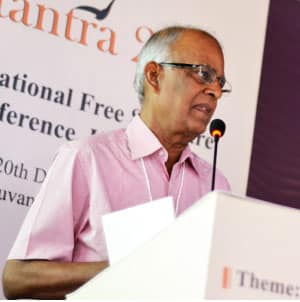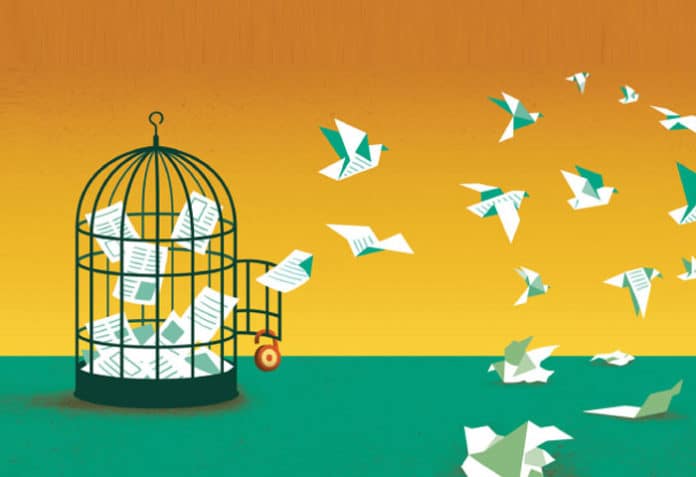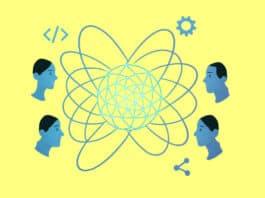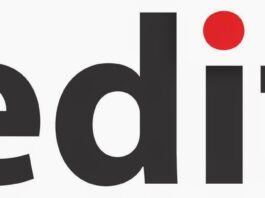Read on to find out why open access makes sense for India, despite the roadblocks here.
Read on to find out why open access makes sense for India, despite the roadblocks here.
Open access (OA) deals with scholarly research, not software. Like open source, its goal is to encourage creativity and productivity, even while ensuring that barriers to access are reduced. Through open access, research outputs are distributed online, free from access charges or similar barriers.
Part of this is a response to the extremely high price of some research journals. So high, that even those who write papers in these journals might not be able to afford their subscriptions. Libraries find some journal prices outrageous. By contrast, OA academic journals are sometimes funded through author fees (article processing charges), by institutions, or by consortia. Given their limited financial resources, researchers and institutions in developing countries are the most likely to benefit from the open access initiative.
Gideon Emcee Christian, a proponent of open access, has pointed to the high costs of international subscriptions for libraries. One survey by McCabe and Snyder revealed that in the field of economics, annual library subscription fees ranged from about US$ 190 to about US$ 1,370. In science and technology, internationally, the average annual library subscription fee was US$ 1,200 in 2000. Many libraries in our parts of the globe find such prices unaffordable.

Some 20 years ago, the Budapest Open Access Initiative (BOAI) defined open access for academic literature in the following terms: “[the] free availability on the public internet, permitting any users to read, download, copy, distribute, print, search, or link to the full texts of these articles, crawl them for indexing, pass them as data to software, or use them for any other lawful purpose, without financial, legal, or technical barriers other than those inseparable from gaining access to the internet itself. The only constraint on reproduction and distribution, and the only role for copyright in this domain, should be to give authors control over the integrity of their work and the right to be properly acknowledged and cited.”
For countries like India, talent-rich and resource-poor, such concepts have much relevance. But there are roadblocks in their implementation too.
Campaigning persistently for OA
In India, one of the most persistent campaigners for the cause of OA has been the Chennai-based Subbiah Arunachalam (“Call me Arun,” as he is quick to say). After ages, we recently got back in touch, and the octogenarian was as feisty as I’ve long known him to be.
Way back in December 2003, Stevan Harnad (the Hungarian-born cognitive scientist based in Montreal, Canada, who has long been very active globally in the space of open access self-archiving and EPrints) said, “No one on the planet is more closely and deeply identified with the cause of researchers and journals who lack the resources to make their output openly accessible than Professor Arunachalam. We are deeply grateful for his generous collaboration.” He called the professor “India’s and the developing world’s great advocate for open access.” (See http://cogprints.ecs.soton.ac.uk/.)
Arun is forever circulating texts of various kinds related to the open access campaign. Once he knows you’re interested in the subject, you’ll get a lot of posts from his keyboard.
He has also been following issues such as open science, and gets into conversations with global leaders on these subjects. He has asked the open science team a few questions like: “How can we speed up the acceptance of the culture of open science and adoption of preprints? What specific steps can scientists, funders and governments take?”
Arun, even today, is keen to promote open access to knowledge, especially the knowledge generated by academic and other research institutions in India, e.g., CSIR (Council for Scientific & Industrial Research), DST (Department of Science and Technology), DBT (Department of Biotechnology), DRDO (Defence Research & Development Organisation), DAE (Department of Atomic Energy), Department of Space, ICMR (Indian Council of Medical Research) and ICSSR (Indian Council of Social Science Research), think tanks, and industry-related research institutions.
To his mind, the A2K (access to knowledge) movement is not alien or distant from other related campaigns — FOSS (free and open source software), community radio, the right to information, open access, among others.
True, indeed!
In an interview with the Indian Institute of Science, Arun pointed out that some people call him ‘Mr Open Access, India’, and he sees himself as an advocate of interoperable open access repositories and open science.
Arun explains: “There was resistance in the beginning, but now even journal publishers who opposed OA initially are ready to come on board; however, they also want to retain their profits and are trying to find models [to do so]. Open access is now an accepted idea. According to a 2013 study funded by the European Commission, more than 50 per cent of what is produced in science and technology is available in the open in some form or the other.”
He points out that this has happened “all within the last 20 years.” Major funders such as the Wellcome Trust and the Bill and Melinda Gates Foundation are supporters of open access.
Why open access?
“If knowledge in the sciences, including social sciences, is locked up in [costly] subscription journals, only those who subscribe to those journals can access it. Unless all the knowledge you need is freely available, your ability to further advance knowledge is limited. If all knowledge is available to all, chances of seeing more knowledge produced are very high. That is the raison d’être for open access,” says Arun.
He adds that researchers in most so-called developing countries are working “under very difficult conditions, especially with regard to information access.”
Internet technologies have the “potential to democratise access to information (and facilitate collaboration),” he says, both for scientific research and rural development. He cites the cases of China and South Korea, which have shown how a country can “lift itself up from a scientific nobody to a world-class performer in a decade or two.” Creating a worldwide information commons, through the establishment of interoperable open access repositories for research papers and scientific data, shows the way.
“The best way to help poor nations is to make them self-supporting by strengthening science in those countries. There is no better means to do that than by adopting the public commons approach to information sharing,” in his view.
The tools available today are inexpensive too. For instance, there is software (EPrints, DSpace, etc) that is free. Help, if needed, to set up such repositories is readily available.
He argues: “Such repositories will facilitate e-science to transform into inclusive science from an activity, at present, of an elitist club of rich nations. They can also help transform the current ‘safari’ kind of research performed by advanced countries into true collaboration with poor countries, especially in areas such as drug development for combating diseases such as malaria and tuberculosis.”
The push for preprints
Arun makes a case for preprints to replace journal articles “as the principal mode of knowledge exchange in science and scholarship.” This basically means that authors who work on a paper willingly submit their work for sharing, in its draft form, so that the flow of knowledge does not get blocked.
In the world of academic publishing, a preprint refers to an early version of a scholarly or scientific paper that precedes formal peer review and publication in a scholarly or scientific journal. It can be shared by its author, often prior to typesetting, free and before it gets published in a journal. Today, there are many preprint repositories. A listing, from A to Z, is available on Wikipedia (https://en.wikipedia.org/wiki/List_of_preprint_repositories).
Arun points out that we have arXiv (with over 2 million preprints deposited over 30 years), bioRxiv, chemRxiv, and other such global preprint servers.
However, not enough is being done in India in this space, he feels. In the meanwhile, commercial publishing companies are playing a domineering role not only in deciding what is and is not important in science but also in evaluating individual researchers and ranking institutions.
Arun notes that, unfortunately, even after two decades post Harnad’s call to researchers worldwide to self-archive, many scientists in India do not “bother to self-archive” and share their work. Sometimes, an intermediary (like a librarian) has to do the archiving.
“In a world of inequality, the open access initiative seeks to provide people all over the world (irrespective of where they live) with equal access to knowledge and information. The developing world stands to gain from the open access initiative but there also are obstacles to its realisation in this world,” says Arun. He points to the many recommendations that governments, educational and research institutions as well as organisations and groups in developed countries need to take up to attain the noble objectives of the open access initiative in the developing world.
| Different models of open access |
| GREEN: Self-archiving by authors. An author can post work to a website controlled by self, an institution that is funded, or an independent repository. Readers can download without paying. If an author posts a near-final version of his/her work after peer review, the archived version is called a ‘postprint’. It can be the accepted manuscript as returned by the journal to the author after successful peer review.
GOLD: Publisher makes all articles and content available for free immediately on the journal’s website — articles licensed for sharing and reuse via Creative Commons licences or similar. This may follow an ‘author-pays’ model. HYBRID: Mix of open access and closed access articles. The publisher is partially funded by subscriptions, and provides open access for articles where the author or research sponsor pays a publication fee. It costs more than gold and can offer a lower quality of service. ‘Double dipping’ is where both authors and subscribers are charged, and is considered a controversial model. BRONZE: Free to read only on the publisher’s page, but lacks a clearly identifiable licence. Usually, no reuse is allowed. DIAMOND: Authors are not charged an article processing charge (APC). Often, the journal requires funding from external sources — advertisements, academic institutions, learned societies, philanthropists or government grants. This model is usually small and multilingual. |
Indian initiatives
So, how are Indian OA initiatives faring?
Some journals have been shifting over to open access. These include journals published by various councils and academies, and a few by private publishers too. Yet, many Indian researchers still publish in “toll-access journals.” There’s a workaround here, though. Researchers and scholars can make their post-prints available. Efforts are on to “persuade” them to do so.
For instance, the prestigious IISc (Indian Institute of Science) in Bengaluru has a repository. It was the first to be set up in India, and one of the earliest in the world. Yet, Arun complains, the faculty and students “don’t seem to be taking it seriously.”
Interestingly, although the DST, DBT and CSIR mandate that research funded by them should be published for open access, researchers don’t take it seriously and these agencies don’t enforce it. “Science policy is not just about tabling reports before committees; it is also about persuading decision-making bodies to adopt certain policies and take action,” Arun argues.
| Concepts related to OA |
| Access to knowledge movement Creative Commons Directory of Open Access Journals Freedom of information Guerilla Open Access Open access mandate Open access monograph Open Access Scholarly Publishers Association Open Access Week Open data Open educational resources Open government Predatory publishing debate Right to internet access [Source: Wikipedia] |
In an online discussion, Francis Jayakanth, one of the active contributors to this space, noted that, to date, about 55,500 Indian Institute of Science (IISc) articles have been uploaded to the IISc’s institutional repository, ePrints@IISc (eprints.iisc.ac.in). Besides, the IISc has roughly 62K items in the Scopus database, which spans the years 1908 to 2022. So, the ePrints@IISc repository has a bit more than 90 per cent coverage of IISc publications. In terms of full-text inclusion in the repository, this is believed to be somewhere between 80 and 85 per cent.
Arun argues: “I wish other IR (institutional repository) managers in India make available such information about their repositories. I have often heard that the IISc repository has only metadata (or bibliographic details) and NOT full texts. Also, I have heard people say that it is NOT a genuine OA repository as the content there is not ‘author self-archived’ but drawn from a database. Does that really matter? As for me, as long as a repository provides the full texts of papers, users need not worry about how they came into the repository in the first place. Yes, it would be ideal if authors self-archive.”
He sees his journey promoting OA as having started before 2000, “although I may not have used the term open access. The terms I used in those days (and continue to use till now) are ‘access’ and ‘visibility’.”
| External links |
|
Some of the problem areas he feels will continue to grow include “commercial publishers bundling journals, and extending their influence to matters concerning research evaluation, academic assessments and ‘ranking’.” Arun also believes that the “publishing oligarchy” has entrenched itself and is now wielding enormous control and influence and “we (scientists and scholars) are trying to retrieve what is rightfully our territory from the usurpers.”




